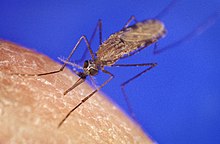Culicomorpha: Difference between revisions
m Open access bot: doi added to citation with #oabot. |
Update reference |
||
| Line 10: | Line 10: | ||
See text for families. |
See text for families. |
||
}} |
}} |
||
The '''Culicomorpha''' are an [[infraorder (biology)|infraorder]] of [[Nematocera]], including [[mosquito]]es, [[black fly|black flies]], and several extant and extinct families of insects.<ref>{{ |
The '''Culicomorpha''' are an [[infraorder (biology)|infraorder]] of [[Nematocera]], including [[mosquito]]es, [[black fly|black flies]], and several extant and extinct families of insects.<ref name=Borkent-2012>{{cite journal |last=Borkent |first=Art |title=The pupae of Culicomorpha : morphology and a new phylogenetic tree |journal=Zootaxa |volume=3396 |issue=1 |year=2012 |url=https://mosquito-taxonomic-inventory.myspecies.info/sites/mosquito-taxonomic-inventory.info/files/Borkent%202012.pdf |doi=10.11646/zootaxa.3396.1 |isbn=978-1-86977-957-3 |oclc=807999306}}</ref> They originated 176 million years ago, in the Triassic period. There are phylogenetic patterns that are used to interpret bionomic features such as differences in the nature of blood-feeding by adult females, daytime or nighttime feeding by adult females, and occurrence of immature stages in aquatic habitats.<ref>{{Cite book |last=Borkent |first=Art |url=https://www.worldcat.org/oclc/807999306 |title=The pupae of Culicomorpha : morphology and a new phylogenetic tree |date=2012 |publisher=Magnolia Press |isbn=978-1-86977-957-3 |location=Auckland, N.Z. |oclc=807999306}}</ref> |
||
Most adult, females lay their eggs on bodies of water. Some are restricted to very clean waters, but others can tolerate highly polluted environments.<ref>{{Cite book |url=https://www.worldcat.org/oclc/899273856 |title=Ecology and General Biology |date=2015 |publisher=Academic Press |others=James H. Thorp, D. Christopher Rogers |isbn=978-0-12-385027-0 |edition=4th |location=London |oclc=899273856}}</ref> |
Most adult, females lay their eggs on bodies of water. Some are restricted to very clean waters, but others can tolerate highly polluted environments.<ref>{{Cite book |url=https://www.worldcat.org/oclc/899273856 |title=Ecology and General Biology |date=2015 |publisher=Academic Press |others=James H. Thorp, D. Christopher Rogers |isbn=978-0-12-385027-0 |edition=4th |location=London |oclc=899273856}}</ref> |
||
Many adults transmit parasites or diseases that can be debilitating or fatal to humans, such as [[malaria]] and [[West Nile virus]]. Biting midges can transmit an extensive range of pathogens of veterinary importance, including [[Akabane orthobunyavirus|Akabane virus]], [[bovine ephemeral fever]] virus, [[Schmallenberg orthobunyavirus|Schmallenberg virus]], [[African horse sickness]] virus, [[Epizootic hemorrhagic disease virus|epizootic haemorrhagic disease virus]], and [[Bluetongue disease|bluetongue virus]].<ref>{{Cite journal |last1=Carpenter |first1=Simon |last2=Groschup |first2=Martin H. |last3=Garros |first3=Claire |last4=Felippe-Bauer |first4=Maria Luiza |last5=Purse |first5=Bethan V. |date=October 2013 |title=Culicoides biting midges, arboviruses and public health in Europe |
Many adults transmit parasites or diseases that can be debilitating or fatal to humans, such as [[malaria]] and [[West Nile virus]]. Biting midges can transmit an extensive range of pathogens of veterinary importance, including [[Akabane orthobunyavirus|Akabane virus]], [[bovine ephemeral fever]] virus, [[Schmallenberg orthobunyavirus|Schmallenberg virus]], [[African horse sickness]] virus, [[Epizootic hemorrhagic disease virus|epizootic haemorrhagic disease virus]], and [[Bluetongue disease|bluetongue virus]].<ref>{{Cite journal |last1=Carpenter |first1=Simon |last2=Groschup |first2=Martin H. |last3=Garros |first3=Claire |last4=Felippe-Bauer |first4=Maria Luiza |last5=Purse |first5=Bethan V. |date=October 2013 |title=Culicoides biting midges, arboviruses and public health in Europe |journal=Antiviral Research |volume=100 |issue=1 |pages=102–113 |doi=10.1016/j.antiviral.2013.07.020 |issn=1872-9096 |pmid=23933421|doi-access=free }}</ref><ref>{{Cite journal |last1=Carpenter |first1=S. |last2=Veronesi |first2=E. |last3=Mullens |first3=B. |last4=Venter |first4=G. |date=April 2015 |title=Vector competence of Culicoides for arboviruses: three major periods of research, their influence on current studies and future directions |url=https://pubmed.ncbi.nlm.nih.gov/26470451 |journal=Revue Scientifique et Technique (International Office of Epizootics) |volume=34 |issue=1 |pages=97–112 |doi=10.20506/rst.34.1.2347 |issn=0253-1933 |pmid=26470451}}</ref> |
||
==Classification== |
==Classification== |
||
Revision as of 16:53, 14 April 2023
| Culicomorpha | |
|---|---|

| |
| Scientific classification | |
| Domain: | Eukaryota |
| Kingdom: | Animalia |
| Phylum: | Arthropoda |
| Class: | Insecta |
| Order: | Diptera |
| Suborder: | Nematocera |
| Infraorder: | Culicomorpha Hennig, 1948 |
| Superfamilies | |
|
Culicoidea | |
The Culicomorpha are an infraorder of Nematocera, including mosquitoes, black flies, and several extant and extinct families of insects.[1] They originated 176 million years ago, in the Triassic period. There are phylogenetic patterns that are used to interpret bionomic features such as differences in the nature of blood-feeding by adult females, daytime or nighttime feeding by adult females, and occurrence of immature stages in aquatic habitats.[2]
Most adult, females lay their eggs on bodies of water. Some are restricted to very clean waters, but others can tolerate highly polluted environments.[3]
Many adults transmit parasites or diseases that can be debilitating or fatal to humans, such as malaria and West Nile virus. Biting midges can transmit an extensive range of pathogens of veterinary importance, including Akabane virus, bovine ephemeral fever virus, Schmallenberg virus, African horse sickness virus, epizootic haemorrhagic disease virus, and bluetongue virus.[4][5]
Classification
Extant families
- Superfamily Culicoidea
- Dixidae -meniscus midges
- Corethrellidae -frog-biting midges
- Chaoboridae -phantom midges
- Culicidae -mosquitoes
- Superfamily Chironomoidea
- Thaumaleidae -solitary midges
- Simuliidae -black flies and buffalo gnats
- Ceratopogonidae -biting midges
- Chironomidae -nonbiting midges
Extinct families
- Asiochaoboridae (Upper Jurassic)
- Architendipedidae (Upper Triassic)
- Protendipedidae (Middle Jurassic)
- Mesophantasmatidae (Middle Jurassic)
References
- ^ Borkent, Art (2012). "The pupae of Culicomorpha : morphology and a new phylogenetic tree" (PDF). Zootaxa. 3396 (1). doi:10.11646/zootaxa.3396.1. ISBN 978-1-86977-957-3. OCLC 807999306.
- ^ Borkent, Art (2012). The pupae of Culicomorpha : morphology and a new phylogenetic tree. Auckland, N.Z.: Magnolia Press. ISBN 978-1-86977-957-3. OCLC 807999306.
- ^ Ecology and General Biology. James H. Thorp, D. Christopher Rogers (4th ed.). London: Academic Press. 2015. ISBN 978-0-12-385027-0. OCLC 899273856.
{{cite book}}: CS1 maint: others (link) - ^ Carpenter, Simon; Groschup, Martin H.; Garros, Claire; Felippe-Bauer, Maria Luiza; Purse, Bethan V. (October 2013). "Culicoides biting midges, arboviruses and public health in Europe". Antiviral Research. 100 (1): 102–113. doi:10.1016/j.antiviral.2013.07.020. ISSN 1872-9096. PMID 23933421.
- ^ Carpenter, S.; Veronesi, E.; Mullens, B.; Venter, G. (April 2015). "Vector competence of Culicoides for arboviruses: three major periods of research, their influence on current studies and future directions". Revue Scientifique et Technique (International Office of Epizootics). 34 (1): 97–112. doi:10.20506/rst.34.1.2347. ISSN 0253-1933. PMID 26470451.
